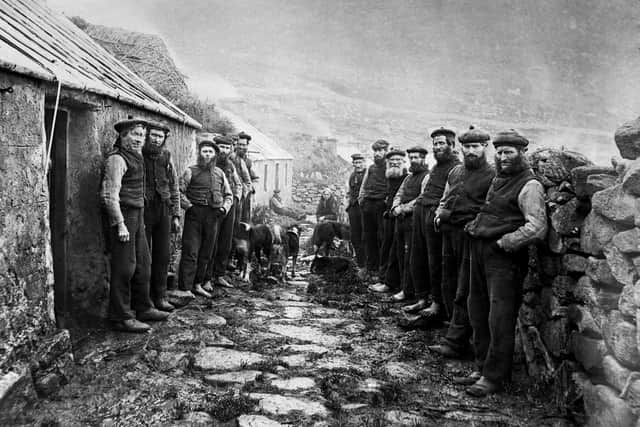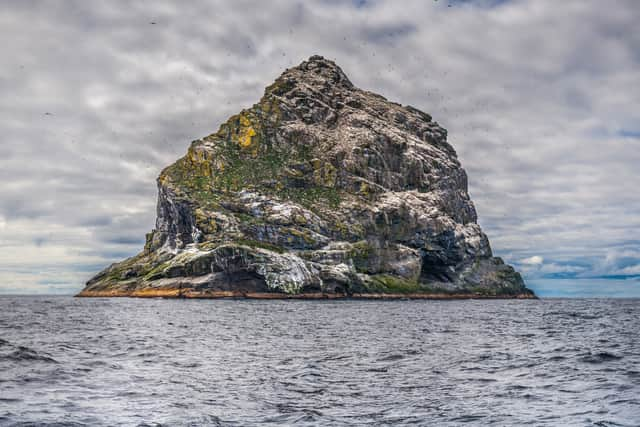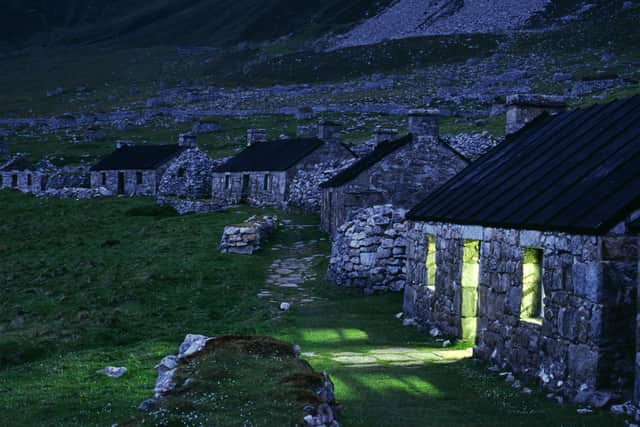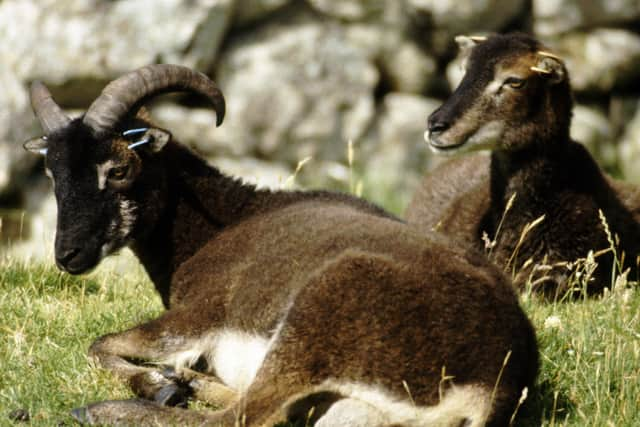The Story of St Kilda: Scotland’s Gaelic-speaking community forever lost to time
Hirta, Soay, Boreray and Dun… These are the four main islands in the remote North Atlantic that form the awe-inspiring archipelago of St Kilda. Remnants of the rim of an ancient volcano, millennia of being weathered, glaciated and carved by fierce Atlantic storms have chiselled the dramatic landscape into what visitors describe as the ‘most inhospitable’ of its kind.
Yet, just as the strongest steel is forged by the fires of hell, the extraordinary vertical cliffs and sea stacks of St Kilda could never have been without the toughest of elements beating them into shape and this is just as true of the St Kildans; the archipelago’s native population.
Advertisement
Hide AdAdvertisement
Hide AdAccording to the National Trust for Scotland: “A community existed here for at least 4,000 years, exploiting the dense colonies of gannets, fulmars and puffins for food, feathers and oil.
“The final 36 islanders were evacuated in 1930.”
Pristine oceanic waters and some of the highest cliffs in Europe have led St Kilda to support a stunning range of animals and plants including the largest seabird colony in Britain and life unique to the islands. This life unique to St Kilda also extends to the remarkable people that lived on the unforgiving terrain since antiquity; theirs is a story of human endeavour that boasts tenacity, hardiness and gratitude both for their land and each other.
In the 1690’s one Martin Martin - a native Gaelic speaker from the Isle of Skye - set off on a voyage to the faraway outpost to record firsthand its culture and natural history. In his account ‘A Voyage to St. Kilda’, Martin wrote:
“The inhabitants of St Kilda, are much happier than the generality of mankind, as being almost the only people in the world who feel the sweetness of true liberty, simplicity, mutual love and cordial friendship, free from solicitous cares, and anxious covetousness; and the consequences that attend them.”
As the westernmost islands of the Outer Hebrides - a heartland of Scottish Gaelic - historians also note that St Kildans spoke a unique dialect of the Celtic tongue that may have been influenced by Old Norse. Alas, the people that bore this distinctive culture and way of life have since been lost to time, never to return to what was as the islands are under new ownership.
For this reason, St Kilda holds the profound title of being the UK’s only mixed UNESCO World Heritage Site as a national nature reserve and important cultural landscape. This year marked the 93rd anniversary of the evacuation of St Kildans - seeing many off to the mainland where they experienced running tap water and other novelties for the first time.
For a Scot-inhabited skerry of untold generations certainly occupied by humans for millennia, how can it be that in a historical blink of an eye this society was suddenly no more?
This is an exploration of the life and death of St Kilda; a people who lived life on the edge in every sense of the expression.


Brief History of St Kilda
Advertisement
Hide AdAdvertisement
Hide AdVisit Outer Hebrides writes: “Originally settled by humans between four and five thousand years ago, St Kilda’s distance from the rest of the Outer Hebrides allowed for the development of a unique style of self-sufficient island life that remained much preserved until the archipelago’s eventual abandonment…”
Scholars note that traces of Neolithic sites and Norse communities exist that predate the settlement of Gaelic-speaking Scots. In recorded history this population peaked at 200 people despite the perilous environment they lived in. Life was tough, however, and it became increasingly difficult to sustain as the population declined and interaction with outsiders increased in the 19th and early 20th centuries.
By the 1920s, following a dramatic crop failure and many islanders facing starvation, they decided to evacuate their ancestral home. This took place on August 29, 1930, when the settlement was only 36 people strong. Of course, emigration from St Kilda had started much earlier. In 1852, three dozen islanders left for new opportunities in Australia and the native population dipped to roughly 70.
In 1911, census data reveals that the population was at 74 and 71 only a decade later. The dwindling population deduced that their way of life was less sustainable than ever and if their children were to have a future they had to leave. In the following years, St Kildans were reported to return for summers in their old houses but the outbreak of WW2 saw this come to an end, with the village falling into disrepair thereafter.
In 1957, the army established a radio station for the purpose of monitoring a missile testing range on South Uist. The site was bequeathed to the National Trust for Scotland that same year and has since “been awarded a number of local, and worldwide, protections for the environment and heritage they contain.”


The Origin of the Name
At a glance it is easy to believe that St Kilda is named after a religious figure. In an earlier period of their history, their faith was described as “a mixture of Druidism and Popery” but definitely they were introduced to Christianity later on which had a devout following there. However, it is not named in honour of a real saint. So, where does that name come from?
According to Gaelic Place-Names of Scotland: “The Gaelic, and original, form is Hiort (Hirt in 1202).
“The difference between the two forms came about from a well on the island called Tobar Chiolda.
Advertisement
Hide AdAdvertisement
Hide Ad“Tobar means ‘well’ in Gaelic, and the other element derives from the Norse kelda, also meaning a ‘well’.
“This name was mistakenly taken to be a saint’s name, and then this was taken to be the name of the whole island.
“This newer form is first on record from around the seventeenth century, and was likely coined by seamen.”
The debate between etymologists is ongoing, however. Some believe ‘Kilda’ is a corruption of ‘Skildir’ which comes from the Old Norse word for a shield - potentially in reference to the shape of St Kilda when observed while out at sea. With regards to the main island of Hirta, the Scottish Society for Northern Studies reports:
“The late Dr. A.B. Taylor found a reference to ‘Hirtir’ in an Icelandic saga dated 1202.
“He suggested that the word meant ‘Stags’ (from the Old Norse hjörtur), referring to the appearance of the group as seen from a heaving Viking ship.”
In other words, it possibly derives from the islands’ antler-like appearance. Others suggest that Hirta comes from the Norse ‘hirt’ which refers to a Shepherd. This is consistent with the neighbouring island Soay which researchers confidently connect to the Norse ‘Seyðoy’ meaning ‘Sheep Island’.
Soay Sheep are a unique breed that originate from this island, little is known about how they arrived there but even today they can be found on Hirta. According to Secret Scotland: “With few external disturbances, the isolated colony has become the subject of scientific observation regarding evolution, and other related work, with the breed dating back to the Bronze Age.”
How did St Kildans survive?
Advertisement
Hide AdAdvertisement
Hide Ad"The inhabitants, completely isolated from the rest of the world, live on the products which nature furnishes them." (‘The Island Of St. Kilda’ Travelogue in 1908 by British Pathé.)
How does one inhabit the uninhabitable? For a terrain almost swallowed whole by the Atlantic many would assume that St Kildans fed primarily on fish but this is not so. The Spirit of the Highlands and Islands project reports that “no trees or shrubs grew on the islands making the community and any sewn food crop vulnerable to the extreme and often volatile weather conditions.”
Therefore, wood was scarce and the few boats the islanders possessed were too precious to risk on regular fishing trips. Instead, they cultivated crops in Hirta’s soil, farmed sheep, cattle and ponies, and - most famously - scaled cliff faces to hunt for seabirds. For context, these are some of the most enormous cliffs in all the British Isles and the ‘Cragsmen’ that braved them used ropes woven from horsehair to do so.
Birds were arguably of the greatest importance to St Kildans as they compensated for crop or stock failures and thus enabled their survival against all other odds. Kilda Cruises explains: “The meat was dried and stored and the eggs were eaten; their oil provided fuel for lamps, and their feathers were stored and sold to the few visitors who came to the island.
“The St Kildans were very economical, they had to be.
“Every part of the bird was used: the beaks became brooch-pins, the bones were fashioned into needles, the skins of gannets were turned into shoes.”
British Pathe’s footage of St Kilda from 1908 shows the islands’ men risking their lives to hunt birds which was “not a pastime but an industry”. The film text reads: “Necessity is the mother of invention. In St Kilda, birds are not shot with a gun but captured with a line.
“The men daily risk their lives in their search for Guillemots eggs on the sides of the precipitous cliffs.”
It concludes: “There is no ‘buroo’ (unemployment benefits) here.”
Advertisement
Hide AdAdvertisement
Hide AdLife was hard so locals needed to be hardy and most importantly hardworking. The islands offer little resources but St Kildans made the most of them to create stone tools which they used to construct homes built of rocks and cleits i.e., unique dry-stone dens that were scattered across the land serving as storehouses or shelters. Visitors documenting life there dubbed the outpost as “the island of a thousand cleits”.
Occasionally, trading occurred with visitors from the outside world but the severity of Atlantic winters and storms meant it couldn’t happen regularly and islanders were often cut off for months at a time. In truly perilous times when facing starvation etc., locals had an iconic ‘message in a bottle’ method of sending letters to the mainland which was known as “St Kilda Mail”.
Floating containers that held their message were connected to buoyant sheep bladders that would float to the mainland which meant their requests were “left to the mercy of the waves”.
Wilderness Scotland summarises: “The islanders faced their share of calamity, but by and large, life followed its familiar patterns through the centuries.
“Life would not have been all that different to the life of subsistence agriculture common across Europe throughout the middle ages, save for one key aspect: isolation.
“And so the most crucial element of island life was this: self-sufficiency.”
What language did they speak?
The language of St Kildans was a ‘unique’ form of Scottish Gaelic. Kenneth Macaulay, a Church of Scotland minister who visited in 1758, published ‘The History of St. Kilda’ which includes a description of what he encountered during a time when the local population had dwindled to only 88.
Describing their language, Macaulay wrote it is “a very corrupt dialect of Gaelic, adulterated with a little mixture of the Norwegian tongue.
Advertisement
Hide AdAdvertisement
Hide Ad“They have many words and cant phrases, quite unintelligible to their neighbours.
“Their manner of pronouncing is attended with a very remarkable peculiarity; every man, woman, and child has an incorrigible lisping; not one of them is able to give their proper sounds to the liquid letters.”
Some accounts assert that other visitors of the island refute this claim that the Gaelic was ‘unusual’ but sadly it is virtually impossible to corroborate either way as the islanders’ tongue was lost as they evacuated their homeland and assimilated into an ever-increasingly anglocentric Scottish mainland.
According to Omniglot: “The website Tobar an Dualchais has some recordings of Gaelic, spoken by original residents of St Kilda.”


Why was St Kilda abandoned?
Ultimately, the inhabitants of St Kilda evacuated their home at their own request. As written by Charles Maclean in ‘The Story of St Kilda’: “Their society was viable, utopian even; but in the nineteenth century the islands were discovered by missionaries, do-gooders and tourists, who brought with them money, disease and despotism.
“In 1930, the few remaining islanders were evacuated, no longer able to support themselves.”
In 1726, a resident left the islands to visit Harris where he took ill with smallpox and died. His clothes were returned the next year but carried the disease on them which led to nearly all the islanders dying. By the 19th century, St Kilda was marketed as a tourist attraction and steamers frequently dropped off visitors intrigued by the islanders’ ‘quaint’ lifestyle.
Secret Scotland tells us: “This marked the point where the islanders began to lose their unique way of life, and ultimately the end of St Kilda’s community.”
Advertisement
Hide AdAdvertisement
Hide AdReports state that the locals were cheated out of possessions by tourists taking advantage of them. The economy afforded to them via tourism allowed them to enjoy conveniences like tinned food but it also made their seabird harvests redundant and so the community of talented labourers began to lose the skills that were their greatest asset for countless generations.
It was also noted that Victorian tourists too often regarded St Kildans as though they were animals at a zoo as their way of life was ‘primitive’ from their perspective. Many photographs of tourists posing with the natives as well as footage captured in documentaries at the time reveal a local population that were disgruntled by their treatment and made to feel uncomfortable.
Of course, these visitors (who brought common disease to the St Kildans who had no immunity) soon disappeared after the islanders were badly affected by illness, weak harvests and food shortages. Other guests, like the Reverend John Mackay who resided on the archipelago from 1865 to 1889, reportedly compelled the islanders to attend church daily which harmed their ability to combat famine as they had less time to cultivate crops and recover their seabird harvest.
In ‘Life in St Kilda’ it is said that John Sands described Mackay as “a well meaning but feeble-minded, irresolute but domineering fanatic.”
An outbreak of influenza in 1913 and the aftermath of WW1 saw inhabitants even more down on their luck as regular food and mail deliveries were lost and many able-bodied youths chose to leave meaning those remaining were at an even greater disadvantage. All of this culminated in a petition sent to the Secretary of State for Scotland (William Adamson) in May, 1930, pleading for support in evacuation.
The final 36 people left their home on the HMS Harebell that August.
Maclean (1977) wrote: “The morning of the evacuation promised a perfect day. The sun rose out of a calm and sparkling sea and warmed the impassive cliffs of Oiseval. The sky was hopelessly blue and the sight of Hirta, green and pleasant as the island of so many careless dreams, made parting all the more difficult. Observing tradition the islanders left an open Bible and a small pile of oats in each house, locked all the doors and at 7 am boarded the Harebell. Although exhausted by the strain and hard work of the last few days, they were reported to have stayed cheerful throughout the operation. But as the long antler of Dun fell back onto the horizon and the familiar outline of the island grew faint, the severing of an ancient tie became a reality and the St Kildans gave way to tears.”


Who was the last surviving native of St Kilda?
According to The Telegraph the last surviving native of St Kilda, Rachel Johnson, died in 2016 aged 93 spending her final years in a care home in Clydebank, Dunbartonshire. Johnson was only a child aged 8 when she and her family were evacuated from the Atlantic archipelago. The general manager for countryside and islands north at the National Trust for Scotland, Alexander Bennett, said her death marked the end of an era.
Advertisement
Hide AdAdvertisement
Hide AdIn his words: “It is a sad day and truly the end of an era to learn that the last of the native St Kildans has passed away.
“I was privileged enough to have met Rachel on a number of occasions. She was intensely private but extremely kindly.”
Reports state that a gentle smile would light up Johnson’s face with even a small mention of St Kilda.


Final Thoughts on St Kilda
Maclean writes: “St Kilda remains a symbol of the ability of man to survive in the most hostile of environments and it remains a fascination unique among islands.”
Despite being viewed as rudimentary by many visitors, one cannot help but wonder if their sense of superiority was gravely misplaced. After all, the inhabitants of the archipelago may have been cut off from conveniences of the modern world but they were also cut off from the complications of it.
The wind-battered landscape they called home may have lacked contemporary finesse but it also willed the people to work harder as a collective, fostering an unrepeatable community spirit and culture that would have been tight knit and - arguably - unrecognisable in today’s world.
As Martin noted in his observations back in 1698, the St Kildans were a simple people but this simplicity of lifestyle was in many ways their blessing. Although we can outsource our needs and desires to a wealth of third parties nowadays it is telling that community spirit is at concerning lows in Scotland with psychologists noting that ‘loneliness’ is ‘at an all-time high’.
Some philosophers muse that past generations lived physically challenging but spiritually peaceful lives and now the opposite is true. Regardless, to glorify the past without acknowledging the tremendous privileges of the present would be ill-considered.
Advertisement
Hide AdAdvertisement
Hide AdOne does wonder, however, given that much of the downfall of St Kilda arose from intervention by outsiders, what would have become of the plucky volcanic islands if they had been left undisturbed? Would it not sit abandoned by its native peoples now or was the evacuation an inevitability merely expedited by the final precursors discussed above?
What’s for sure is a unique way of life, culture and language vanished along with the St Kildans and if we don’t want the same fate for what remains of our heritage then we must protect it.
Comments
Want to join the conversation? Please or to comment on this article.
